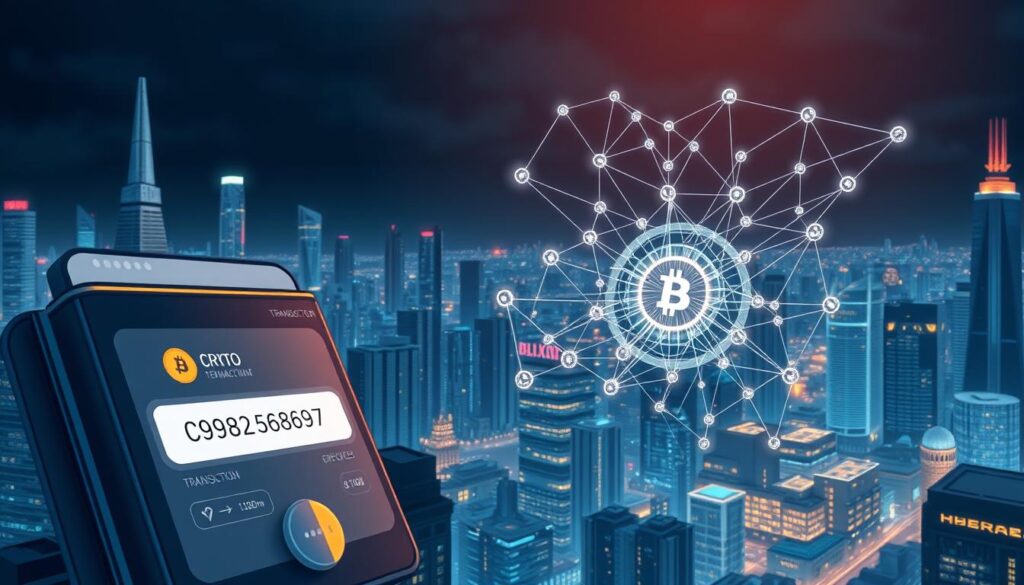Imagine a financial system where payments bypass banks and borders. This is the reality of digital currency, a revolutionary approach to value exchange. Unlike paper money controlled by governments, these assets operate through decentralized networks powered by advanced technology.
At its core, this system relies on blockchain – a shared digital ledger that records transactions securely. Every trade gets verified by multiple computers worldwide, eliminating the need for middlemen. This structure ensures transparency while preventing fraud or manipulation.
Traditional banking often involves delays, high fees, and limited access. Decentralized alternatives solve these issues through peer-to-peer networks. Users can transfer funds globally within minutes, even without bank accounts.
Adoption continues growing as businesses and individuals recognize the benefits. From faster settlements to reduced costs, the advantages reshape how we handle money. This guide breaks down the mechanics behind these innovations and their real-world applications.
Key Takeaways
- Digital currencies operate without central authorities like banks or governments
- Blockchain technology ensures secure, transparent transaction records
- Peer-to-peer networks enable faster global payments with lower fees
- Decentralized systems increase financial accessibility worldwide
- Understanding these systems helps navigate modern financial opportunities
Introduction to Cryptocurrency
The launch of Bitcoin in 2009 sparked a financial revolution. This event introduced cryptocurrency – digital money secured by unbreakable code. Unlike traditional currency, these assets aren’t controlled by banks or nations.
Cryptography forms the backbone of these systems. Complex algorithms validate transactions and limit new coin creation. Value depends on network strength and user adoption, not government policies.
Today’s market features over 10,000 cryptocurrencies, from Bitcoin to niche tokens. Each serves unique roles, like smart contracts or private payments. Explore crypto transaction processes for deeper insights.
Public ledgers record every exchange transparently. Users interact pseudonymously, balancing privacy with accountability. This structure empowers people excluded from conventional banking.
Decentralization prevents single-point failures. Networks spread across countless computers ensure continuous operation. This resilience makes digital currency systems attractive for global commerce.
what is cryptocurrency and how it works
Secure, borderless transactions redefine value exchange without central oversight. These systems rely on blockchain networks – interconnected computers maintaining identical transaction records. Each action gets encrypted and time-stamped, creating irreversible audit trails.

Public-key cryptography safeguards asset transfers through unique digital signatures. Users prove ownership using paired codes – one shared, one private. This method prevents unauthorized changes while enabling transparent verification.
Validation processes maintain network integrity through collective effort. Participants called miners or validators:
- Confirm transaction legitimacy using advanced algorithms
- Bundle verified actions into permanent blocks
- Earn crypto rewards for securing the system
Smart contracts automate complex agreements without third parties. These self-executing programs trigger payments when preset conditions occur – from insurance claims to royalty distributions.
Global accessibility remains a key advantage. A smartphone and internet connection enable instant cross-border transfers, often cheaper than traditional remittance services. This efficiency stems from eliminating currency conversions and intermediary fees.
Blockchain Technology and Digital Currency
Digital trust systems achieve security through distributed consensus mechanisms. At their core, these networks use blockchain technology to maintain synchronized records across multiple devices. This approach eliminates single points of failure while ensuring universal access to transaction histories.

How Blockchain Creates a Secure Ledger
Every transaction forms a data block containing three elements: sender/receiver details, timestamp, and a unique code linking to prior entries. Network participants verify new blocks through mathematical challenges, creating irreversible records. Once added, altering information requires rewriting every subsequent block on all connected computers – an impossible feat for large networks.
Decentralized validation prevents tampering. Nodes cross-check each new entry against existing ledger copies. Discrepancies trigger automatic rejection, maintaining system-wide consistency. This process removes reliance on centralized authorities for transaction approval.
Cryptography and Data Integrity in Crypto
Advanced encryption transforms transaction details into unreadable formats during transfers. Only intended recipients with matching code pairs can decode the information. Hash functions act as digital fingerprints – altering any detail changes the entire output, exposing fraud attempts instantly.
Consensus protocols like Proof-of-Work synchronize network updates. Participants must solve complex equations to validate blocks, ensuring unanimous agreement on ledger states. This cryptographic framework enables trustless interactions between strangers while protecting asset ownership records.
A Brief History and Evolution of Cryptocurrency
Digital money’s origin story begins decades before Bitcoin’s rise. Early attempts at creating a first cryptocurrency surfaced in the 1990s, but technical limitations hindered adoption. The breakthrough came in 2008 when an anonymous developer published the Bitcoin whitepaper under the pseudonym Satoshi Nakamoto.
The Emergence of Bitcoin and Altcoins
Bitcoin launched in 2009 as the first functional decentralized currency. Its blockchain solved critical issues like double-spending through proof-of-work validation. This innovation sparked global interest in cryptocurrency as both technology and investment.
Three key developments shaped the ecosystem:
- Creation of alternative coins (Litecoin, 2011) addressing Bitcoin’s speed limitations
- Ethereum’s 2015 debut enabling programmable smart contracts
- Stablecoin launches (2017-2018) bridging traditional finance with digital assets
The market expanded from one cryptocurrency to over 20,000 options today. Major corporations now hold Bitcoin reserves, while governments explore digital currencies. This evolution birthed new sectors like DeFi platforms and NFT marketplaces.
Despite volatility, cryptocurrencies demonstrate staying power. From underground experiment to trillion-dollar asset class, these innovations continue redefining global finance.
Understanding Crypto Transactions
Direct value exchanges between users define modern financial interactions. Crypto transactions bypass traditional gatekeepers through encrypted networks that validate peer-to-peer transfers. This system combines security with unprecedented accessibility.

Peer-to-Peer Transfer Mechanics
Initiating a transfer requires three components:
- Recipient’s public wallet address
- Transfer amount
- Digital signature proving asset ownership
Network validators confirm transaction details within minutes. Unlike bank transfers, these verifications occur globally across thousands of devices. Most networks charge fees under $1 – a fraction of conventional remittance costs.
| Feature | Cryptocurrency | Traditional Banking |
|---|---|---|
| Speed | 2-60 minutes | 1-5 business days |
| Cost | $0.10 – $5 | $25 – $50+ |
| Availability | 24/7/365 | Business hours |
| Security | Blockchain encryption | Centralized safeguards |
Transfers finalize when validators add transactions to immutable blockchain blocks. Larger amounts often require multiple confirmations for enhanced security. Users must double-check wallet addresses – completed payments cannot be reversed.
The IRS classifies digital assets as taxable property. Capital gains rules apply when trading or spending cryptocurrency. Proper record-keeping helps navigate tax obligations effectively.
Cryptocurrency vs Traditional Currency

Global financial systems now face competition from borderless digital alternatives. Physical currency issued by governments requires centralized management through banks and mints. Digital assets operate through code-based protocols that no single authority can alter.
Fiat money derives value from government mandates and economic policies. Central banks adjust supply through quantitative easing or interest rate changes. Cryptos like Bitcoin follow mathematical rules – only 21 million coins will ever exist, creating predictable scarcity.
| Feature | Traditional Currency | Crypto |
|---|---|---|
| Control | Central banks/governments | Decentralized networks |
| Supply Management | Adjustable through policies | Algorithmic caps |
| Transaction Speed | 1-3 business days | 2-60 minutes |
| Account Security | FDIC insurance up to $250k | User-controlled wallets |
| Global Transfers | High fees, currency conversion | Low cost, direct exchange |
Traditional systems offer deposit protection but restrict access during non-business hours. Crypto networks enable 24/7 transactions between strangers without approval processes. This freedom increases financial inclusion but shifts security responsibilities to users.
Market forces differently impact value in both systems. National currencies fluctuate based on trade balances and inflation rates. Digital assets experience volatility from tech updates and adoption trends. Investors must understand these dynamics when allocating funds.
Investment Risks and Opportunities in the Crypto Market
Navigating digital asset markets demands awareness of shifting reward-risk dynamics. Prices swing rapidly – Bitcoin’s 2021 surge to $69,000 followed by 70% drops exemplifies this volatility. Yet strategic investors recognize patterns beneath the turbulence.
Market Volatility and Long-Term Value
Short-term price fluctuations often stem from regulatory news or tech breakthroughs. Over 90% of altcoins vanish within five years, but established networks like Ethereum show sustained growth. Long-term value emerges from real-world utility and adoption rates.
Diversification reduces exposure to single-asset crashes. Allocate portions to:
- Market leaders with proven track records
- Emerging platforms solving specific industry needs
- Stablecoins for risk mitigation during downturns
Newcomers should start small – even 1% portfolio exposure provides learning opportunities. Cryptocurrency investment tips emphasize dollar-cost averaging to smooth entry points. This approach lessens timing risks in unpredictable markets.
Regulatory clarity continues evolving, creating both challenges and openings. While some nations restrict trading, others develop frameworks protecting investors. Staying informed helps capitalize on shifting landscapes while managing legal risks.


No comments yet